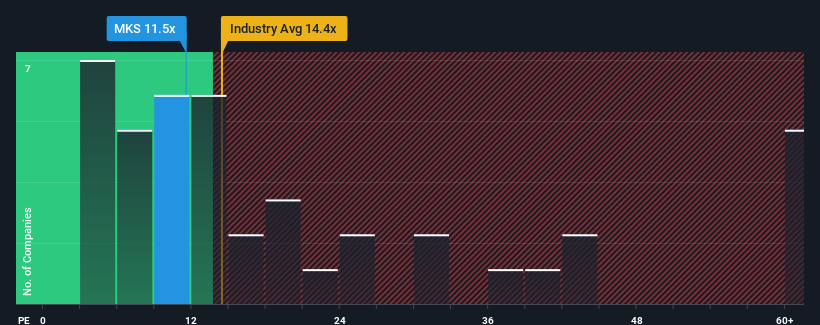Marks and Spencer Group plc's (LON:MKS) Subdued P/E Might Signal An Opportunity

With a price-to-earnings (or "P/E") ratio of 11.5x Marks and Spencer Group plc (LON:MKS) may be sending bullish signals at the moment, given that almost half of all companies in the United Kingdom have P/E ratios greater than 16x and even P/E's higher than 29x are not unusual. Although, it's not wise to just take the P/E at face value as there may be an explanation why it's limited.
With its earnings growth in positive territory compared to the declining earnings of most other companies, Marks and Spencer Group has been doing quite well of late. One possibility is that the P/E is low because investors think the company's earnings are going to fall away like everyone else's soon. If not, then existing shareholders have reason to be quite optimistic about the future direction of the share price.
View our latest analysis for Marks and Spencer Group

Does Growth Match The Low P/E?
Marks and Spencer Group's P/E ratio would be typical for a company that's only expected to deliver limited growth, and importantly, perform worse than the market.
Taking a look back first, we see that the company grew earnings per share by an impressive 29% last year. However, the latest three year period hasn't been as great in aggregate as it didn't manage to provide any growth at all. Therefore, it's fair to say that earnings growth has been inconsistent recently for the company.
Looking ahead now, EPS is anticipated to climb by 10.0% per annum during the coming three years according to the analysts following the company. With the market predicted to deliver 11% growth per year, the company is positioned for a comparable earnings result.
With this information, we find it odd that Marks and Spencer Group is trading at a P/E lower than the market. It may be that most investors are not convinced the company can achieve future growth expectations.
What We Can Learn From Marks and Spencer Group's P/E?
It's argued the price-to-earnings ratio is an inferior measure of value within certain industries, but it can be a powerful business sentiment indicator.
We've established that Marks and Spencer Group currently trades on a lower than expected P/E since its forecast growth is in line with the wider market. When we see an average earnings outlook with market-like growth, we assume potential risks are what might be placing pressure on the P/E ratio. It appears some are indeed anticipating earnings instability, because these conditions should normally provide more support to the share price.
A lot of potential risks can sit within a company's balance sheet. Take a look at our free balance sheet analysis for Marks and Spencer Group with six simple checks on some of these key factors.
Of course, you might also be able to find a better stock than Marks and Spencer Group. So you may wish to see this free collection of other companies that have reasonable P/E ratios and have grown earnings strongly.
New: Manage All Your Stock Portfolios in One Place
We've created the ultimate portfolio companion for stock investors, and it's free.
• Connect an unlimited number of Portfolios and see your total in one currency
• Be alerted to new Warning Signs or Risks via email or mobile
• Track the Fair Value of your stocks
Have feedback on this article? Concerned about the content? Get in touch with us directly. Alternatively, email editorial-team (at) simplywallst.com.
This article by Simply Wall St is general in nature. We provide commentary based on historical data and analyst forecasts only using an unbiased methodology and our articles are not intended to be financial advice. It does not constitute a recommendation to buy or sell any stock, and does not take account of your objectives, or your financial situation. We aim to bring you long-term focused analysis driven by fundamental data. Note that our analysis may not factor in the latest price-sensitive company announcements or qualitative material. Simply Wall St has no position in any stocks mentioned.
About LSE:MKS
Very undervalued with proven track record.


